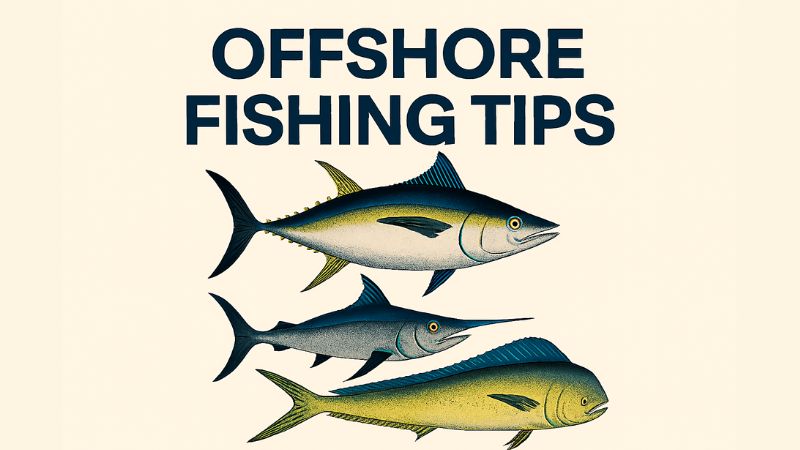Offshore Fishing Tips: How to Target Tuna, Marlin & Mahi‑Mahi
For many anglers, offshore fishing is more than a sport — it’s a pursuit that combines strategy, endurance, and a deep connection to the open ocean. Few experiences rival the adrenaline rush of watching a rod arc over, line screaming off the reel, as a massive tuna, marlin, or mahi‑mahi fights to free itself.
In this guide, we’ll break down exactly where, when, and how to target these pelagic powerhouses, from reading the water to selecting the right tackle. You’ll also learn proven techniques, seasonal patterns, and gear setups that can turn a long boat ride into the trip of a lifetime.
Understanding the Stars of Offshore Fishing
Tuna — Speed, Strength, and Stamina
- Species focus: Yellowfin (Thunnus albacares), Bluefin (Thunnus thynnus), and Albacore (Thunnus alalunga).
- Behavior: Tuna are constant movers, following bait balls, temperature breaks, and nutrient‑rich currents like the Gulf Stream.
- Seasonal cues: Warm months are peak for yellowfin and mahi‑mahi; cooler seasons may bring bluefin closer to shore.
Marlin — The Apex Predator
- Species focus: Blue Marlin (Makaira nigricans), Black Marlin (Istiompax indica), Striped Marlin (Kajikia audax).
- Hunting style: Ambush feeders that use bursts of speed to attack baitfish near the surface.
- Prime grounds: Drop‑offs, seamounts, and canyon edges where upwelling concentrates prey.
Mahi‑Mahi — The Neon Sprinters
- Scientific name: Coryphaena hippurus, also known as dolphinfish.
- Habitat: Often found near weed lines, floating debris, and warm current edges.
- Behavior: Aggressive feeders, often in schools, striking both live and artificial bait.
The Gear That Wins Offshore Battles
Rods, Reels, and Line
- Tuna: 30–80 lb class rods with high‑capacity conventional reels (e.g., Shimano Tiagra, Penn International).
- Marlin: 80–130 lb gear for heavy trolling spreads and long fights.
- Mahi‑Mahi: 20–50 lb tackle is sufficient, making them fun on lighter setups.
- Lines: Braided mainline for capacity, fluorocarbon leader for invisibility.
Terminal Tackle & Lures
- Trolling lures: Kona heads, skirted baits, jet heads for marlin and tuna.
- Live baits: Ballyhoo, sardines, mackerel — bridled or nose‑hooked.
- Hooks: Circle hooks for better hook‑up ratios and easier releases.
Finding Fish — Reading the Ocean Like a Pro
Key Oceanographic Indicators
- Temperature breaks: Use SST charts to locate areas where warm and cool water meet.
- Current edges: Nutrient‑rich zones that attract bait and predators.
- Bird activity: Frigatebirds and terns hovering or diving indicate feeding fish beneath.
Species‑Specific Clues
- Tuna: Look for surface busts, sonar marks, or birds chasing flying fish.
- Marlin: Areas holding skipjack or small yellowfin often draw marlin.
- Mahi‑Mahi: Weed lines, driftwood, or buoys often hold fish — visually easy to spot.
Techniques for Targeting Pelagics
Trolling
- Spread setup: Mix lure colors and positions to mimic a school of baitfish.
- Speeds: 6–9 knots for marlin, 7–8 knots for tuna, 5–7 knots for mahi‑mahi.
- Outriggers: Increase spread width and reduce line tangles.
Live Baiting & Chunking
- Live baiting: Drift or slow‑troll live baits over structure or current edges.
- Chunking: Cut bait (tuna belly, mackerel) released steadily to form a scent trail.
Kite Fishing
- Excellent for tuna; keeps baits skipping on the surface, enticing explosive strikes.
Timing Your Trip
Best Seasons
- Tuna: Spring and summer for yellowfin; winter for bluefin in some regions.
- Marlin: Summer into early fall in most tropical and subtropical waters.
- Mahi‑Mahi: Peak in warm months; highly migratory and fast‑growing.
Weather Windows
- Check marine forecasts for wind, swell, and storm systems. Calm seas and stable conditions improve safety and fishing success.
Safety & Preparation for Offshore Runs
- Fuel management: Always carry more than needed — “one‑third out, one‑third back, one‑third reserve.”
- Comms: VHF radio, EPIRB, and satellite tracker.
- Emergency gear: Life jackets, first aid kit, flares.
- Boat readiness: Mechanical check, spare parts, and safety drills.
Conservation & Ethics
- Follow all bag and size limits; check regional regulations.
- Use tag‑and‑release for billfish to aid scientific data collection.
- Avoid over‑harvesting and respect breeding seasons.
Advanced Tips from Pro Captains
- Color matching: Lures that match prevalent baitfish often outperform flashy patterns.
- Double hookups: Keep other lines in the water after the first hook‑up — pelagics often travel in groups.
- Leader length: Longer fluorocarbon leaders increase stealth but can make gaffing harder — balance accordingly.
Species Quick Reference Table
| Species | Best Months (Typical) | Ideal Water Temp | Key Baits/Lures | Notable Hotspots |
|---|---|---|---|---|
| Yellowfin Tuna | May–Sept | 72–82°F | Live mackerel, cedar plugs | Gulf Stream, Pacific offshore banks |
| Blue Marlin | June–Oct | 77–86°F | Large skirted trolling lures | Kona, Azores, Caribbean |
| Mahi‑Mahi | May–Aug | 75–85°F | Ballyhoo, bright trolling lures | Florida Keys, Gulf of Mexico, Indo‑Pacific |
Conclusion
Success in offshore fishing isn’t about luck — it’s the result of planning, understanding your quarry, and mastering your craft. Whether your goal is to land a blistering yellowfin, raise a majestic blue marlin, or fill a cooler with neon‑bright mahi‑mahi, the fundamentals remain the same:
- Locate the right water
- Present the right bait or lure
- Fish at the right time
Combine these elements with safety awareness and conservation ethics, and you’ll not only catch more fish — you’ll ensure the offshore thrill is there for generations to come.
Frequently Asked Questions — Offshore Fishing for Tuna, Marlin & Mahi‑Mahi
1. What is the best month to fish for tuna offshore?
It depends on the species and region. In many warm‑water zones, yellowfin tuna peak from May to September when currents like the Gulf Stream or Kuroshio bring bait inshore. Bluefin tuna often appear closer during cooler months in temperate areas, such as December to March in parts of the Atlantic.
2. What trolling speed works best for marlin?
Most captains troll for marlin at 6–9 knots, adjusting slightly based on lure type and sea conditions. Heavier skirted lures may be run faster, while lighter baits perform better at moderate speeds to maintain natural movement.
3. Where can I find mahi‑mahi offshore?
Mahi‑mahi love structure and shade. Look for weed lines, floating debris, buoys, or driftwood in warm blue water between 75–85°F. These areas often hold baitfish, drawing mahi‑mahi to feed aggressively near the surface.
4. What is the ideal rod and reel setup for offshore tuna fishing?
For yellowfin and similar‑sized pelagics, a 30–80 lb class rod paired with a high‑capacity conventional reel like a Shimano Tiagra or Penn International is ideal. Spool with braided mainline and a fluorocarbon leader for stealth and strength.
5. How do I safely release a marlin?
Use circle hooks to reduce deep hooking, keep the fish in the water if possible, and handle the leader carefully to avoid injury to both fish and crew. Remove the hook with long‑nose pliers or cut the leader close to the mouth before swimming the fish to revive it.
6. Is live bait or artificial better for mahi‑mahi?
Both work — mahi‑mahi are opportunistic feeders. Live ballyhoo, sardines, or pilchards are irresistible, but bright skirted trolling lures and feather jigs also produce well, especially when you need to cover more water.
7. How far offshore do I need to go for big‑game fishing?
It depends on your local continental shelf and currents. In some locations, deep blue water starts 5–10 miles out, while in others you may need to run 30–60 miles to reach prime tuna and marlin grounds.
8. What safety gear is essential for offshore trips?
Carry a VHF marine radio, EPIRB, life jackets, flares, first‑aid kit, and ensure your boat’s mechanical systems are in top condition. Always inform someone onshore of your float plan before departure.
9. How do I spot a temperature break?
Use SST (Sea Surface Temperature) charts or onboard electronics. A sudden shift of even 1–2°F can indicate a current edge where baitfish and predators gather.
10. What’s the advantage of kite fishing for tuna?
Kite fishing keeps baits on the surface, creating a distressed baitfish presentation that often triggers explosive strikes. It’s especially effective in calm to moderate seas for targeting finicky or shy tuna.

